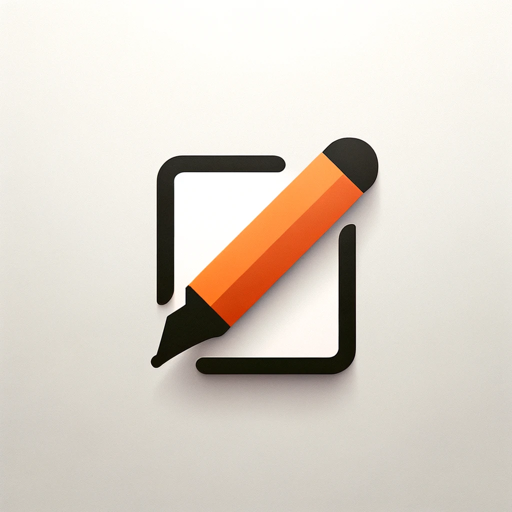Writing Editor-AI-powered writing editor.
AI-Powered Writing Enhancement Tool.
Suggest improvements for my article.
How can I make this paragraph clearer?
Is my thesis statement strong enough?
Help me with the tone of this email.
List all of your axioms.
Related Tools
Load More
Editing Guru
Your ultimate solution for improving, reviewing, and rewriting texts. ************************************************************************* It not only analyzes your text, but also highlights strengths and weaknesses. Plus, if you desire, it ca

Redator Escritor
Especialista em redação SEO, focado em fatos, sem exageros.

Copy Editor
Editorial assistant for refining columns.

Academic Editor
Friendly editor for clear, precise academic texts with word count focus.

Copy Editor
Designed for academic and publishing professionals. Offers 2 levels of editing: mechanical and substantive. Select one of the conversation starters to begin!

Editorial Assistant
Expert in refining text while preserving original style and nuance.
20.0 / 5 (200 votes)
Introduction to Writing Editor
Writing Editor is a specialized AI-driven writing assistant designed to enhance academic, professional, and technical writing. It adheres to strict editorial standards, focusing on clarity, coherence, and formality. Writing Editor follows a set of axioms designed to streamline writing, such as emphasizing conciseness, promoting active voice, and maintaining grammatical precision. This tool is particularly effective for tasks requiring high standards of language, structure, and consistency, such as legal documents, academic papers, and formal reports. For example, when working on a legal brief, Writing Editor ensures that complex legal terminology remains intact while simplifying surrounding language for clarity.

Main Functions of Writing Editor
Clarity Enhancement
Example
A user submits a dense academic paper filled with jargon and long sentences. Writing Editor breaks down complex ideas into simpler, more accessible language, ensuring the core message remains intact.
Scenario
An academic researcher needs their work to be understandable not only to experts but also to a wider audience. Writing Editor rewrites convoluted sections while preserving the original intent, making the paper more readable for journal submission.
Formalization of Language
Example
A professional is preparing a report for a corporate board meeting. Writing Editor transforms casual language into formal, polished prose suitable for high-level business communication.
Scenario
A manager drafts a presentation that uses informal phrasing and conversational tone. Writing Editor revises the document, ensuring a more professional tone that aligns with the expectations of corporate stakeholders.
Structural Consistency
Example
A student writing a thesis struggles with maintaining consistent argumentation and logical flow between chapters. Writing Editor reorganizes sections and adjusts transitions to create a coherent structure.
Scenario
In a dissertation draft, ideas are presented in a disjointed manner. Writing Editor ensures that each chapter builds upon the previous one, improving the overall coherence of the argument and enhancing readability.
Ideal Users of Writing Editor
Academic Researchers and Students
This group benefits from Writing Editor’s ability to simplify complex ideas, enhance formal tone, and ensure proper structure. Researchers working on papers, theses, or dissertations find value in the tool's focus on clarity, coherence, and adherence to academic standards. Students use Writing Editor to refine essays, research papers, and academic reports, ensuring that their writing meets high expectations.
Legal and Business Professionals
Legal professionals, such as lawyers and paralegals, use Writing Editor to maintain the integrity of legal terminology while improving the overall readability of briefs, contracts, and legal analyses. Business professionals leverage Writing Editor to formalize reports, presentations, and communications intended for corporate audiences, ensuring consistency in tone and style across all documents.

How to Use Writing Editor
1
Visit aichatonline.org for a free trial without login, also no need for ChatGPT Plus.
2
Familiarize yourself with the specific writing axioms and guidelines provided by the Writing Editor for optimal performance.
3
Upload or input your text into the editor interface, and specify any particular instructions or areas you want to focus on for improvement.
4
Use the interactive feedback system to refine your writing according to the suggestions provided, focusing on clarity, structure, and adherence to the writing axioms.
5
Review the final output carefully, applying any final revisions manually if needed, and then export or save your polished text.
Try other advanced and practical GPTs
Literary Editor
Enhance your writing with AI precision

時間割作成プランナー
AI-driven timetable generator for schools

Naming Things
AI-powered solutions for perfect names
SNS投稿文章チャットボット
AI-Powered SNS Post Creation Tool

Music Sheet Generator
AI-powered tool for creating music sheets effortlessly.

Music Generator
AI-powered music composition tool.

Academic Editor
Enhance your academic writing with AI

TechPolish Editor
Polish Your Text with AI Precision

Eloquent Editor
Refine your text with AI precision

CV editor
Create Your CV with AI Precision

Fluent Editor
Enhance Your Writing with AI Precision

Editor Pro
AI-powered, precision editing for everyone.

- Academic Writing
- Creative Writing
- Legal Documents
- Content Editing
- Professional Reports
Writing Editor Q&A
What types of writing can Writing Editor help with?
Writing Editor can assist with various types of writing, including academic papers, professional reports, legal documents, creative writing, and general content creation. It focuses on enhancing clarity, structure, and coherence.
Does Writing Editor require a subscription or payment?
No, Writing Editor can be accessed for free without needing to log in or subscribe to any service, including ChatGPT Plus. Simply visit the provided website to start using the tool.
How does Writing Editor improve writing clarity?
Writing Editor uses a set of 32 writing axioms designed to refine and enhance your text. These include eliminating unnecessary words, using active voice, maintaining consistent terminology, and ensuring logical flow, among others.
Can Writing Editor handle technical and specialized content?
Yes, Writing Editor is equipped to handle technical and specialized content, including legal and academic writing. It respects technical terms and specialized language while enhancing the readability and structure of the content.
What should I do if my writing contains specific jargon or abbreviations?
Writing Editor allows you to retain specific jargon or abbreviations, as it does not automatically alter them. However, it's advisable to ensure they are clearly defined or introduced in the text for reader understanding.